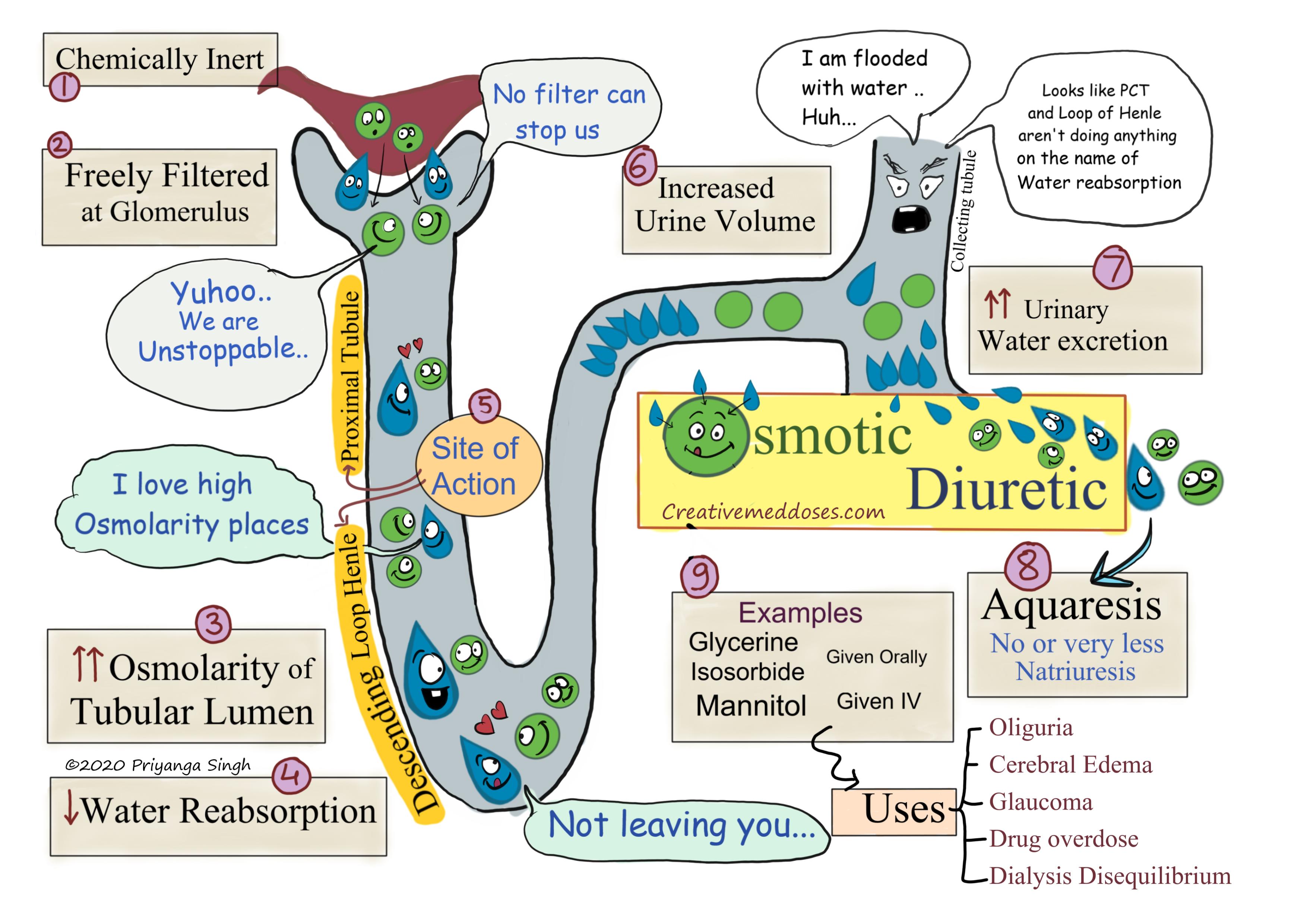Osmotic Diuretics: aquaretics without natriuresis
Osmotic diuretics are inert chemical substances which are freely filtered at the glomerulus but are Not Reabsorbed in proximal tubule and loop of Henle. They cause diuresis by increasing urine volume by reducing water reabsorption in proximal tubules and descending loop of Henle.
Examples
- Glycerine - given orally
- Isosorbide - given orally
- Mannitol (prototype of osmotic diuretics)
Given IV (intravenous), is not absorbed orally and, causes osmotic diarrhea if given orally.
Mechanism of Action
First principle to understand – Water/solvent flows from solute of low osmotic concentration towards solute of high osmotic concentration through semipermeable membrane until the equilibrium is achieved at both sides.
All osmotic diuretics including mannitol increases osmotic concentration of blood, and when the blood reaches to glomerulus, these substances are filtered freely through glomerulus and reaches into tubular system.
And when they reach into tubular system they are NOT Reabsorbed by tubules (osmotic diuretics works at Proximal Tubule and Descending loop of Henle).
Since they are present in tubular fluid in high concentration, it increases osmotic pressure within tubular lumen of proximal tubule and the loop of Henle.
This leads to reduced water reabsorption (because water stays in solute of high osmotic concentration that is tubular lumen). This increases volume of tubular filtrate and urine volume.
Increased urinary volume causes increased water loss in urine (aquaresis) with no or negligible loss of sodium (no natriuresis). Therefore, osmotic diuretics are not useful in conditions with sodium retention.
...

...
Indications for using mannitol
Oliguria
Prevention of acute renal injury in cases of oliguria, where GFR is extremely low (in patients of shock and trauma). Administration of osmotic diuretics increases urine flow even in cases with low GFR which prevent anuria. Osmotic diuretics are used to increase water excretion in preference to Na+ excretion. Urine volume can be maintained even when the glomerular filtration (GFR) rate is low.
Drug overdose
Osmotic diuretics may promote urinary excretion of toxic substances such as cisplatin.
Acute glaucoma
Glaucoma is an elevation of the intraocular pressure (IOP) with associated optic nerve and retinal damage. Osmotic diuretics reduce formation of Aqueous humour by reducing plasma flow through the ciliary body and reduces vitreous humour by increasing blood osmolarity. This leads to reduced intraocular pressure and prevent damage of optic nerve and retina.
Cerebral edema and cases with increased intracranial pressure
The formation of brain/cerebral edema is an intense intracellular and extracellular ion and water exchange process. Increased intracranial pressure in cerebral edema is one of the most important and fatal complications of cerebral injuries.
Raised intracranial pressure can compromise cerebral blood flow and cell metabolism and fixed volume of the skull makes it more fatal and emergent situation, which can lead to critical consequences due to the compression of vital brain structures.
The osmotherapy in form of osmotic diuretics, is of great importance in the management of cerebral edema and increased intracranial pressure (ICP) in cases of brain injury. In addition to osmotic diuretic action, mannitol also constricts cerebral vessels which leads to reduction in intracranial blood volume and pressure.
Dialysis Disequilibrium Syndrome
Dialysis disequilibrium syndrome (DDS) is presence of neurological signs and symptoms due to cerebral edema, during or following aggressive hemodialysis. It presents as focal neurological deficits, papilledema and altered level of consciousness.
It is associated in cases where rapid removal of solute in dialysis causes sudden reduction in blood osmolarity, which leads to water flow into brain parenchyma because now osmolarity of brain tissue is more than blood. This excessive water shift in brain leads to life threatening cerebral edema.
Intravenous mannitol used in the treatment of dialysis disequilibrium syndrome, increases the serum osmolality, and hence decreases the rapid rate of solute removal by dialysis, this slow removal of solute prevents cerebral edema and other consequences of it.
Adverse effects
- The most common side effect is headache. Nausea and vomiting may occur
- Dehydration
- Initial cardiac volumetric strain due to extracellular water expansion from the osmotic effects in the systemic circulation. The expansion of extracellular water occurs because the presence of mannitol in the extracellular fluid extracts water from the cells and can cause volume overload in cases with heart failure and pulmonary edema. It can also cause pulmonary edema as a side effect if given in high doses. Read more on ECF expansion here Mannitol and ECF expansion.
Contraindications
- acute tubular
- necrosis
- anuria
- pulmonary edema
- acute left
- ventricular failure
- CHF
- cerebral haemorrhage
Revision for today “acute respiratory distress syndrome” click here ARDS.
Watch video on masks and covid 19 here MaskUP .
stay tuned and subscribe for updates ….